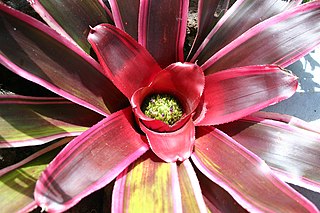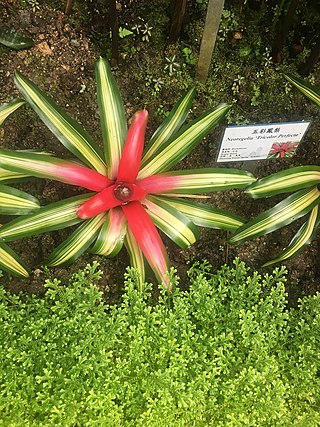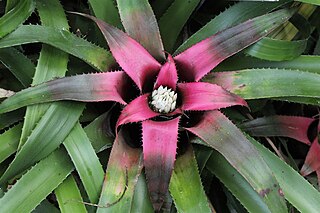
Neoregelia is a genus of epiphytic flowering plants in the family Bromeliaceae, subfamily Bromelioideae, native to South American rainforests. The genus name is for Eduard August von Regel, Director of St. Petersburg Botanic Gardens in Russia (1875–1892).

Bromelioideae is a subfamily of the bromeliads (Bromeliaceae). This subfamily is the most diverse, represented by the greatest number of genera with about 40. Most of the plants in this group are epiphytes, though some have evolved in, or will adapt to, terrestrial conditions. This subfamily features the most plant types which are commonly cultivated by people, including the pineapple.

Nidularium is a genus in the plant family Bromeliaceae, subfamily Bromelioideae. Named to describe the nestling characteristic of the inflorescence, all the species are endemic to Brazil. Commonly confused with Neoregelia which they resemble, this plant group was first described in 1854.

Hylaeaicum eleutheropetalum is a species of flowering plant in the family Bromeliaceae, native to tropical South America. It was first described in 1907.
Rokautskyia pseudoscaposa is a species of flowering plant in the family Bromeliaceae, endemic to Brazil. It was first described by Lyman Bradford Smith in 1955 as Cryptanthus pseudoscaposus.
Neoregelia kerryi is a species of flowering plant in the genus Neoregelia. This species is endemic to Brazil. Its name has also been incorrectly spelt Neoregelia kerryae.
Neoregelia leucophoea is a species of flowering plant in the Bromeliaceae family. It is endemic to Brazil.
Neoregelia silvimontana is a species of flowering plant in the genus Neoregelia. This species is endemic to Brazil. Its name has also been spelt Neoregelia silvomontana.

Neoregelia princeps is a species of flowering plant in the family Bromeliaceae. It is native to Brazil.

Neoregelia schubertii is a flowering plant in the genus Neoregelia. The species is native to Brazil. As of November 2022, the Encyclopaedia of Bromeliads regarded it as a synonym of Neoregelia compacta.

Hylaeaicum is a genus of flowering plant in the family Bromeliaceae, native to tropical northern South America. The taxon was first described by Ernst Heinrich Georg Ule in 1935 as a subgenus of "Aregelia". It was later treated as a subgenus of Neoregelia, before being raised to a full genus in 2021, a status accepted by both Plants of the World Online and the Encyclopaedia of Bromeliads.
Hylaeaicum mooreanum is a species of flowering plant in the family Bromeliaceae, native to Ecuador and northern Peru. It was first described by Lyman Bradford Smith in 1962 as Neoregelia mooreana.
Hylaeaicum myrmecophilum is a species of flowering plant in the family Bromeliaceae, native to northern Brazil, Colombia, Ecuador and Venezuela. It was first described by Ernst Heinrich Georg Ule in 1905.
Hylaeaicum pendulum is a species of flowering plant in the family Bromeliaceae, native to Ecuador and northern Peru. It was first described by Lyman Bradford Smith in 1963 as Neoregelia pendula.
Hylaeaicum stoloniferum is a species of flowering plant in the family Bromeliaceae, native to Colombia, Ecuador, Peru and Venezuela. It was first described by Lyman Bradford Smith in 1963 as Neoregelia stolonifera.
Hylaeaicum levianum is a species of flowering plant in the family Bromeliaceae, native to northern Brazil, Colombia and Venezuela. It was first described by Lyman Bradford Smith in 1968 as Neoregelia leviana.
Hylaeaicum roseum is a species of flowering plant in the family Bromeliaceae, endemic to Peru. It was first described by Lyman Bradford Smith in 1963 as Neoregelia rosea.
Hylaeaicum meeanum is a species of flowering plant in the family Bromeliaceae, endemic to Brazil. It was first described in 1975 as Neoregelia meeana. It was first collected by Margaret Mee, near the source of Rio Andirá, near Parintins. It may be treated as a synonym of Hylaeaicum levianum, but as of November 2022 was accepted by Plants of the World Online and the Encyclopaedia of Bromeliads.
Hylaeaicum tarapotoense is a species of flowering plant in the family Bromeliaceae, endemic to northern Peru. It was first described in 1985 as Neoregelia tarapotoensis. It was first collected near Tarapoto in the Department of San Martín in northern Peru.

Hylaeaicum wurdackii is a species of flowering plant in the family Bromeliaceae, endemic to northern Peru. It was first described by Lyman Bradford Smith in 1963 as Neoregelia wurdackii.








